Game 150, Part III: The Test

In November 2013, The MMQB was granted unprecedented access to an NFL officiating crew before, during and after a Ravens-Bears game at Soldier Field—dubbed Game 150 because that’s the number the NFL assigned it, out of its 256 regular-season games. Part 1 of the three-part series looked at referee Gene Steratore. Part 2 detailed the lives of the seven-man crew. Today, we examine the pre-game rituals, and an unusual Game 150 in stormy Illinois.
Saturday, Nov. 16
Marriott O’Hare,Chicago
At 3:30 p.m., in the tidy 338-square-foot Dearborn Room on the meeting level of this little city of a hotel, 10 NFL employees gather around a large rectangular table. A big screen is on the far wall. Gene Steratore, the referee and leader of the crew for Sunday’s Ravens-Bears game at Soldier Field, is at the head of the table on the right side, and NFL officiating supervisor Gary Slaughter—who will grade the crew’s seven officials on their performance—is at the head on the left. Around the table, clockwise from Steratore: side judge Mike Weatherford, umpire Bill Schuster, replay official Paul Weidner, replay assistant Brian Dipinto, field judge Bob Waggoner, line judge Jeff Seeman, back judge Dino Paganelli and head linesman Wayne Mackie.
I am the interloper, having never sat in on one of these. (Obviously: The NFL customarily keeps all officiating matters behind an iron curtain of secrecy.) So how would I have any idea what the feeling in the room normally is? I wouldn’t.
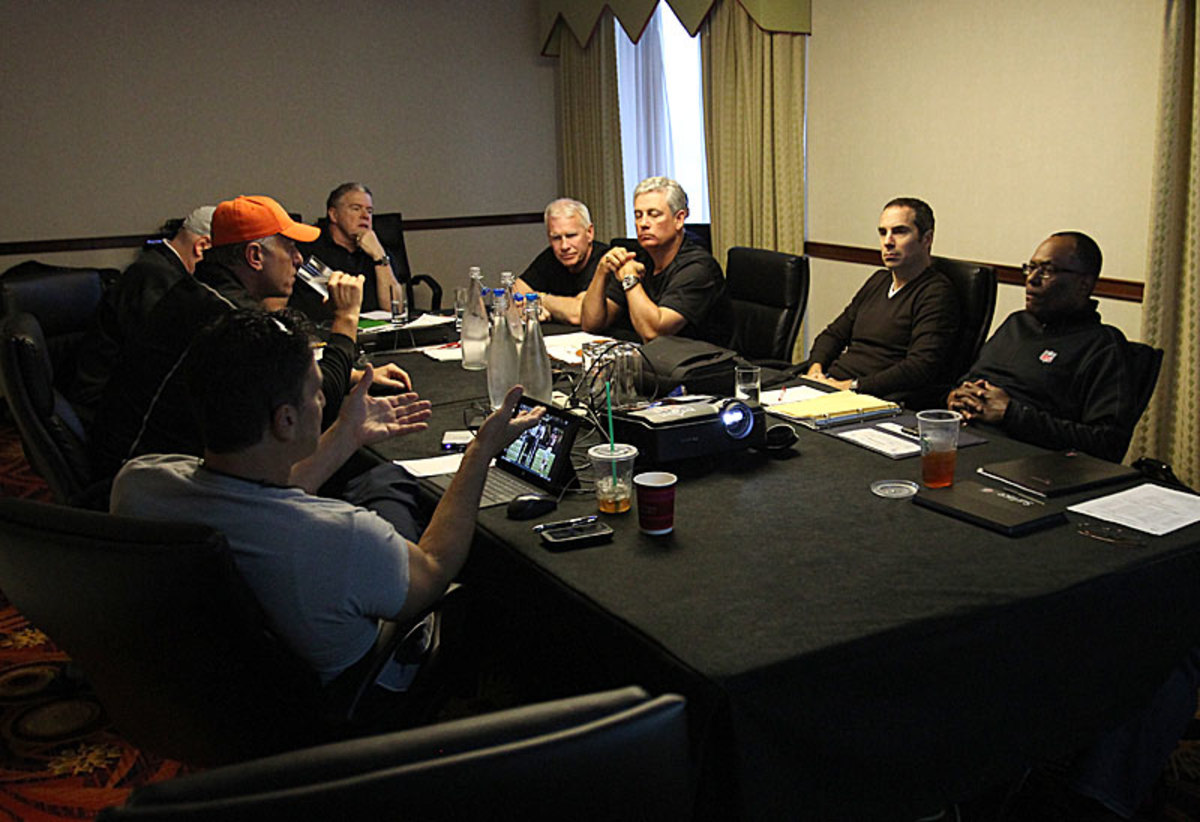
But there seems to be some tightness in this group. Some nerves. One of the first things Steratore says to the room when everyone’s seated is, “Guys, very big game tomorrow.” In part, the previous Sunday in Arizona is why. The crew had its worst day of the year by far: six downgrades upon post-game NFL review for the Texans-Cards game, including two for Steratore, who’d been having a very good year. In NFL parlance, “downgrade” equals “significant error,” and Steratore was glum when he got the news Tuesday. “There goes the Super Bowl,” he’d said. So the Baltimore-Chicago game, for this crew, is a crucial one. The seven field officials have to get back on track, or they risk being left out of the precious high-profile postseason assignments.
Even when Schuster, the gruff resident needler, hears the shirt choice for Sunday’s game—Schuster always prefers short sleeves—and throws in his two cents, the mood doesn’t lighten much.
“We’ll be in long sleeves tomorrow,” says Steratore. “We’re gonna have some weather out there.”
“Unbelievable,” Schuster says, shaking his head. “Why? Can we vote? What’s it called when everyone has a vote?”
“A democracy,” says Seeman.
“We’re a democracy run by a dictator,” Schuster grumbles.
Kidding, kidding.
What got the crew—particularly Steratore—in trouble last week were a couple bad calls on unnecessary roughness (UNR in ref parlance). Steratore chose not to flag two hits on Houston quarterback Case Keenum that the league felt should have been flagged. And so early in this meeting, when Slaughter has the floor, he says in his Texas accent, “Guys, the biggest thing on our radar is UNR. Roughing the quarterback, stay after those. Remember, we want you to err on the side of safety.”
The group watches a tape of plays sent to all crews by NFL vice president of officiating Dean Blandino, who narrates. Blandino shows a good no-call on what was close to a helmet-to-helmet hit, and he illustrates a good referee announcement after another play. Standard stuff for the Steratore crew. Then Steratore shows about 20 plays of the Ravens and Bears, with elements he wants each official to watch for on Sunday. Specifically, they go over positioning. For 23 minutes the tape rolls, and they’re speaking a foreign language, starting with the mechanics of how to officiate a Baltimore running play on which Ray Rice sharply cuts back up the middle.
Steratore: “On a normal scenario, if this is a run, Flacco’s handing this off to Rice or whoever it is. So, this is our POA [point of attack] right here. Which takes me to 73 [right guard Marshal Yanda], thinking about a POA seal. Shoe [Schuster] is also working inside out, so he doesn’t get out on this at all. He’s not really looking to that action. This is not a sweep look.”
Schuster: “Ray Rice cuts it—he’s not playing a lot right now—but that back’s gonna cut right back where the guard-center is. They’re famous for that cutback right at that hash.”
Steratore: “So you know you’re gonna hold now more on this tight end, which is gonna free me to go work 74/73 [right tackle Michael Oher and Yanda] on the back side. Wayne, you’re holding your guy now.”
Schuster: “Now all of the sudden, when I read that, now I have to re-change my keys, and now I’ll pick up that back guard.”
To translate: When quarterback Joe Flacco has a stretch play—either running or play-action—to the left that cuts back quickly up the guard-center gap, assignments are malleable. On a pass, Steratore immediately has both tackles and the quarterback to watch; Schuster would have the three interior offensive linemen. But if Rice takes the handoff, Steratore transitions to cover the right guard and right tackle; Schuster takes the center and left guard. Head linesman Wayne Mackie stays with the tight end in either scenario.
Confused? You’ll never last in this job if you can’t quickly transition from the possibility of a run to play-action pass.
Think of all the motioning and changing of positions on an average play, and remember that each of the 22 players theoretically should be covered by one of the seven field officials at all times. That’s why Steratore and Schuster are trying to get their assignments straight here. They think they’ll see this play tomorrow, perhaps a few times.
Now, Steratore shares a few words about on-field conferences among members of the crew. “They’re good,” he says, “and I want you to have ’em. You know I’m not gonna be in your conversation. You come to a resolution. I’m gonna give you four, five seconds, and then you tell me the call. Have a conviction, and tell me.”
When Steratore was watching Bears tape on Tuesday, he spotted an illegal play by Chicago tight end Martellus Bennett. Steratore highlights it now on tape. On the play, Bennett hooks his left arm into the midsection of Lions defensive end Willie Young. Because Bennett is well-shielded by players on either side of him, it’s hard to see the left arm holding Young from rushing, and twisting him around. Very crafty.
“Look at 83,” Steratore says of Bennett. “Savvy. Very savvy. He does this too good. Tomorrow, any action similar to that is a hold. Got that? If we see it, it’s a hold.”
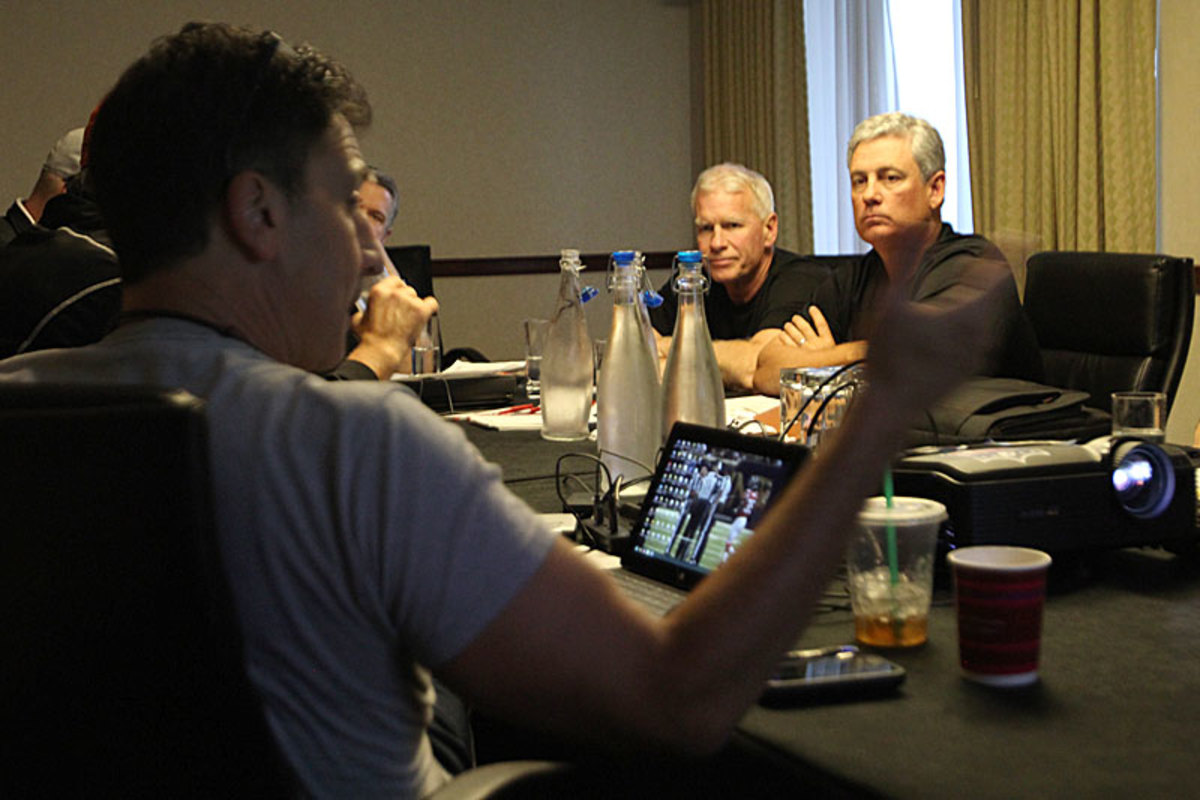
After an hour and a half the meeting winds down. Steratore goes over the schedule for the night and for Sunday: Meet in the lobby at 6 p.m. to walk over to Gino’s East for deep dish pizza; Devotional back in this room Sunday at 7:30 a.m., breakfast available at 7:45, van to the game at 9 for the noon Central start.
Now Steratore wants to set the tone for the game, the same way a head coach tries to do in his Saturday meetings. Listening to Steratore—the tone, the enthusiasm, the seriousness—you might mistake him for a coach. He sounds just like one, standing in front of the crew, moving his gaze from one set of eyes to the other during his seven-minute pep talk:
“We had a good talk on Tuesday, and the good talk on Tuesday leads to one thing and one thing only, and that’s just communicating on this field in all aspects. From pregame, to follows on the field, to plays that we’re talking about. One thing we can’t do—we can’t [just] officiate in our area and stay in our area, and start working as individuals. We never have, and we’re not going to start. Okay?
“Continue to be the kind of official that puts you in the room [among other NFL officials]. That’s a good official … It’s how we work the season as a crew, because that’s where we get our measure of success and satisfaction through the end of the year—no matter what we do in the postseason. Postseason’s irrelevant. Let them handle that in New York. That’s their job. Our job is to handle 15 very difficult football games in a very short window of time. Get mentally prepared—Wednesday finishes the week before—and get your head focused on the next task at hand. That’s a challenge that we all have gone through.
“You guys have lived this every week. It’s no different. The games just get bigger, and the games get harder, and this game is a hard game. Both of these teams … can go from being out of the playoffs to winning their division. So that’s how much is at stake tomorrow. That’s the time of year that we’re in. They’re both aggressive teams. Extremely aggressive teams. Their mark is that they kick people’s asses. Knowing that up front, stop the progress—get the whistles. Set the tone for the game. Talk to these players and get them in and out of stuff. It’s big-boy stuff. Work it the way that we’ve always worked it. We’re back into that rhythm and take care of that business.
“The quarterback this week for Chicago played, what, the last half of the last quarter? He’s not a bad quarterback. Josh McCown can play. These guys got a pretty good offensive line. They’ve got a big wideout with Brandon Marshall; two tight ends a lot of times as well. So they come in with the big set. They come in to kick your ass. Baltimore is struggling like hell to run the football, but I don’t think for one second that they’re gonna throw the ball 54 times tomorrow. They’re gonna keep trying to run the football, okay? So it’s physical football. It’s tough football. They’re coached by two good guys. Communicate with these guys. Get close to those coaches in replay, and walk them through the replay. What we’re looking at, what I come out with—it’s important that what I give to Wags [Waggoner] outside the curtain gets moved to those coaches. I’m not one to sit there to wait for the magic of the microphone. I want him to know what the hell is going on before everybody else knows, so he knows what we’re doing on the field.
“We’ve got to increase our level of communication. Keep trusting each other. Keep working your area, and then go ahead and expand your area …
“Have faith in each other and confidence in each other, and just get the thing moving forward again, alright? Everybody in here is Super Bowl-caliber people. All of you. But you’ve all been around long enough to know the business. So just work the game.
“When it comes down to it, all of this stuff for seven days comes down to the beauty of it—12 o’clock Central time tomorrow we get three hours and ten minutes to do what the hell we do …
“Everybody keep doing what you’re doing. We're having a very great year as a crew. What happens to you all individually happens to you all individually. That’s your business at the end of the day. That’s not where I’m going with this. Come February, I’m happy that the crew finished and had another great season. We’ve got a bunch of big football games on the horizon. This one is a big one tomorrow. Big f------ game tomorrow. Alright? Let’s put this thing right back on track—not that it fell off—but this crew doesn’t sit and talk about four or five downgrades a week.”
Steratore hangs around to watch a few more plays after the rest of the officials leave. He knows it’s a good crew—he wasn’t just blowing smoke. It’s no accident that this crew is assigned to the Denver-New England [Peyton Manning-Tom Brady] game—the third straight Manning-Brady game the Steratore crew has had—or to the Detroit-Green Bay Thanksgiving Day game. This is a well-respected crew. Steratore wants them to be confident Sunday. What he said at the end was right: He thinks the crew has to get back on track after an uncharacteristically shaky game. If it doesn’t, most if not all of them will be home in January. Just as the Bears and Ravens are driving for the playoffs when they play tomorrow, so too are the seven men on this officiating crew.
At dinner, there’s a bottle of wine on the table. The only drinkers are the three civilians—the two representatives of The MMQB, and Steratore’s fiancée, Lisa Mauro, who has made the trip from western Pennsylvania. “Rubbing it in, aren’t you?” Schuster says. The officials cannot drink the day before a game. They are about the only ones in this Chicago pizza bistro who aren’t consuming something alcoholic.
I sit next to Mike Weatherford, the quiet member of the crew. He made what I thought was a very good call in the Houston-Arizona game, a bang-bang touchdown call for Andre Johnson inches from the right boundary stripe. On tape, you see Weatherford staring at the play with bent knees, processing it for half a second, and shooting his arms up in the air. The Cards howled, saying Johnson was out of bounds. But Weatherford turned out to be right on review. “The mechanics of a play like that are feet and then the catch,” he says, meaning see if the feet are in first, then check to see if the receiver has possession. But this one happened way too fast. “You really have to make that call by feel. You have to trust your instincts, that you’ve seen that play so many times.”
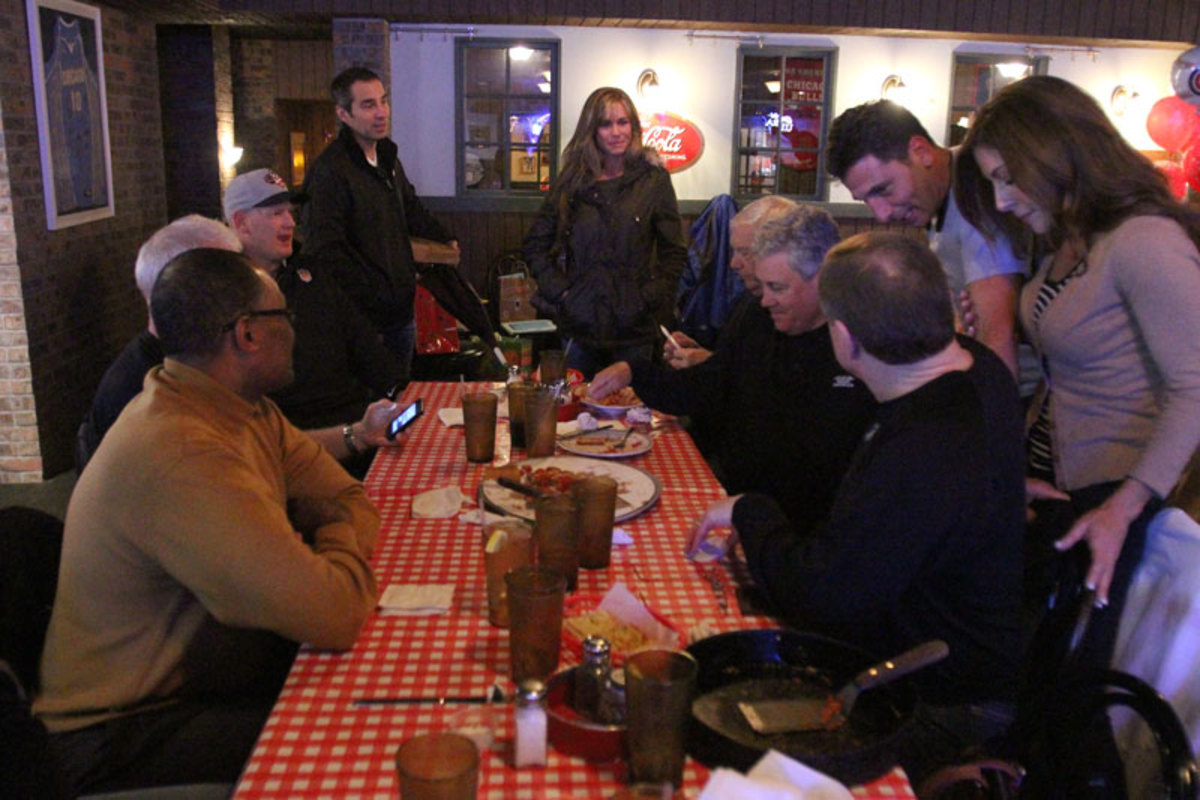
Then we discuss something important to Weatherford: He’s the league’s only Native American official, and the only Native American to have worked a Super Bowl (Green Bay-Pittsburgh three years ago). He’s from the Chickasaw tribe in Oklahoma. He tells me his ancestors were run out of Mississippi on the Trail of Tears—the ethnic cleansing of American Indians in the South 180 years ago—and said that for years being Native American wasn’t a point of pride. “There were Native Americans who scrubbed their faces, trying to look more white,” he said. So doing the Super Bowl was a proud moment not only for his family, but also the 40,000 Chickasaws.
“Officiating in the NFL for me is a dream come true,” he said. “It’s a dream that’s still coming true.”
Rising at 6:30 a.m. in his Marriott room, Steratore gets the iron and ironing board out of the closet. As he’s done before every NFL game he’s officiated, Steratore irons the dress shirt he’ll wear to and from the stadium. Call it a superstition, or call it vanity—Steratore just wants to look his best.
At 7:30, in the same room inside the Marriott where the Saturday meeting was held, Wayne Mackie begins the weekly devotional, with Steratore, Waggoner, Weatherford and Seeman present. Replay official Mark Burns—not on this crew—writes the Christian message each week, and Mackie usually uses it. “God’s way to mental toughness” is today’s message, and for about 20 minutes Mackie imparts the message. Reading from 2 Corinthians, he says: “ … We live by faith, not by sight. We are confident, I say, and would prefer to be away from the body and at home with the Lord. So we make it our goal to please him, whether we are at home in the body or away from it.” Burns’ message, delivered through Mackie: In the officiating life, it’s good to embrace pressure, and thrive on the pressure of competition. Anxiety is inevitable in the arena; you can cope with it through your own Christian mental toughness.
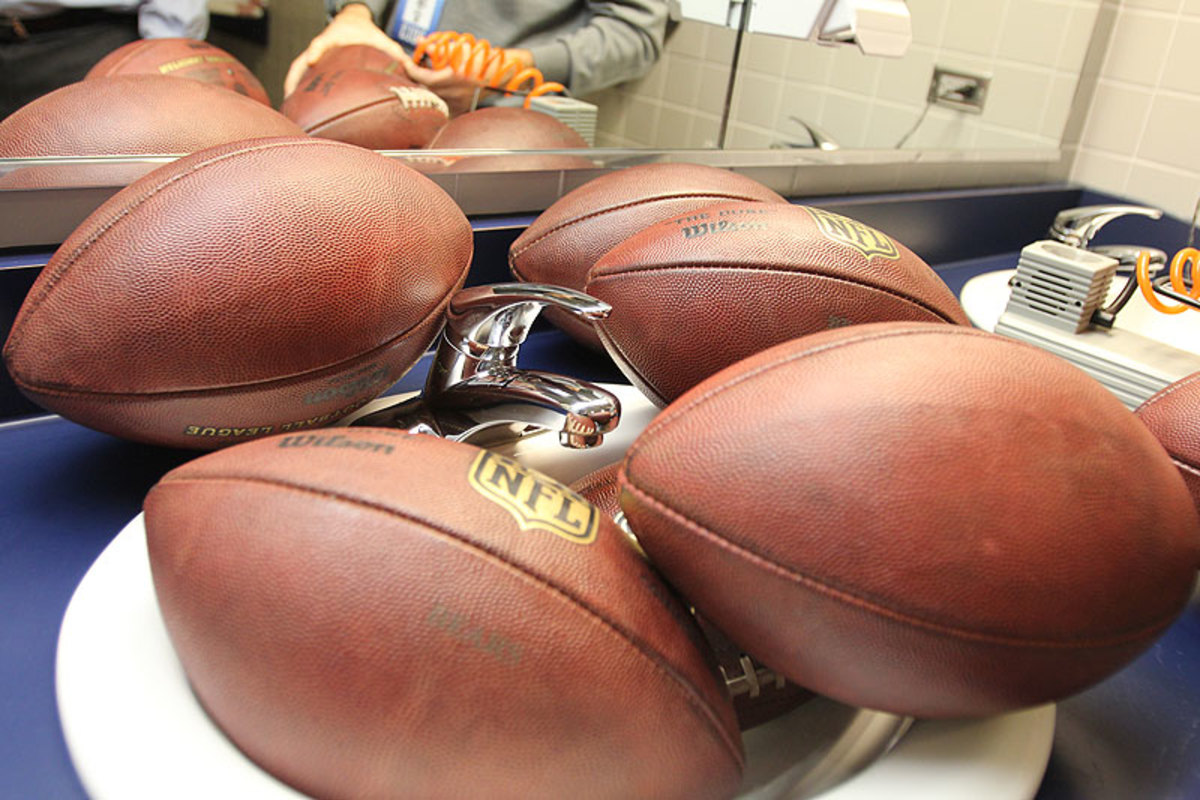
The well-dressed crew—most in sport coats and ties—board the van at 8:55. Coughlin time. “Windy day in the windy city,” Steratore says. “The weather’s really going to be a factor here. We could get a lightning delay, and that would be a huge concern for TV. That just adds to what’s going to be a tough, tough football game to officiate.”
The van pulls into a private drive next to Soldier Field. The day is dank, threatening, windy. Weather’s coming. Getting off the van, they encounter modern stadium security. They put their bags down in a straight line, and a black lab, a bomb-sniffer, has a go at the bags. At 10:20, Steratore will meet with local police, fire and federal agents to be briefed on whether there are any local security threats today, a meeting that’s verboten to write about or for outsiders to attend. And when the officials arrive in their locker room at 9:40, all the little things must get done.
“Thumb drives!” Paganelli says. “Give me your thumb drives.” The back judge is responsible for plugging all the thumb drives into a device that records the game in real time so each official can watch it on his flight home that night. For now, FOX News Sunday is on the TV, but that’ll change by noon.
The Kicking Ball Coordinator (every game has one) walks in and sees Mackie. “Got the ‘K’ balls?” he says, and Mackie hands him the six balls that one team rep from both Baltimore and Chicago will be able to condition for the next 45 minutes; the proviso is they’re only allowed to use brushes, towels and water to get the sheen and wax and new-football feel off for the game.
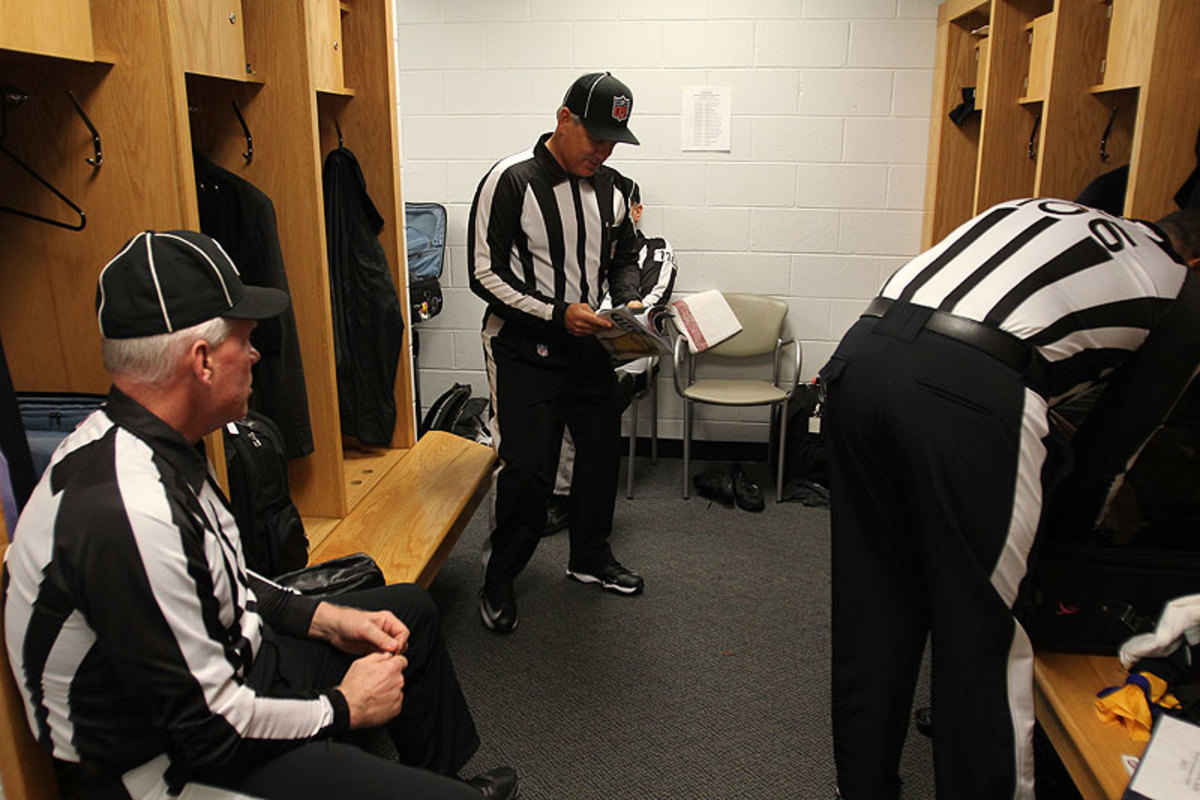
“Got the game balls yet?” Mackie says to the locker-room attendant, and as if on cue an orange bag of 24 game balls arrives from a Bears equipment man. Minutes later the Ravens’ bag of 24 shows up. Usually it’s 12 per team, but with the threat of bad weather each team conditioned 24 balls during the week—the Chicago balls will be used when the Bears are on offense, Baltimore’s when the Ravens have the ball—and now Mackie, Waggoner and Paganelli go to work to get the balls prepared. One by one, as if on an assembly line, Mackie checks with a pressure gauge to see if the balls are filled to 12.5 to 13.5 pounds per square inch of pressure. Those that aren’t get taken to the bathroom. There Paganelli uses an electric pump to fill up the balls, Mackie checks the pressure, and Waggoner puts the good ones in the sink, until all are perfect. Then Waggoner marks each by silver Sharpie with an “L” below the NFL shield, Steratore’s branding of each ball so they’re not confused with other balls found on the sidelines. The “L” is in honor of Steratore’s fiancée.
In another side of the room, Schuster chews on a red Twizzler while filling out a form for each team: Before the first half, he’ll be checking a randomly picked group of players for slippery substances, and he’ll do the same with a different group at halftime. He puts the numbers of the players he’ll be patting down on his “Player Uniform Foreign Substance” card. He says it’s been about 10 years since a player has been caught with silicone on the jersey.
Outside the locker room at 10:18, Waggoner meets the three ballboys for the game. “We’ll have weather today, so be prepared to change balls every play, okay?” One replies: “Yes sir.”
The six ‘K’ balls return at 10:28. “I’ve never had to use six,” says Mackie. “Even on a wet day like this, we’ll probably only get to four.”
Ninety minutes before the game, two officials meet with Bears coach Marc Trestman, two others with Ravens coach John Harbaugh. They synchronize watches for precise time, ask about any special plays the teams plan to run (none on either side), ask for the identity of the Get Back coach (the one who will keep the six-foot-wide white sideline stripe clear), and ask about any concerns they’ve noticed on film from the other team.
Special-teams coaches notably are pesky about what they’ve seen on tape, but today, it’s nothing on tape that bothers them. “Hey See-dog,” Schuster says to Jeff Seeman when he’s returned from his mission to see coaches. “The Baltimore special-teams coach, Jerry Rosburg, just said, ‘Manage the weather conditions.’ ” They get a good laugh out of that.
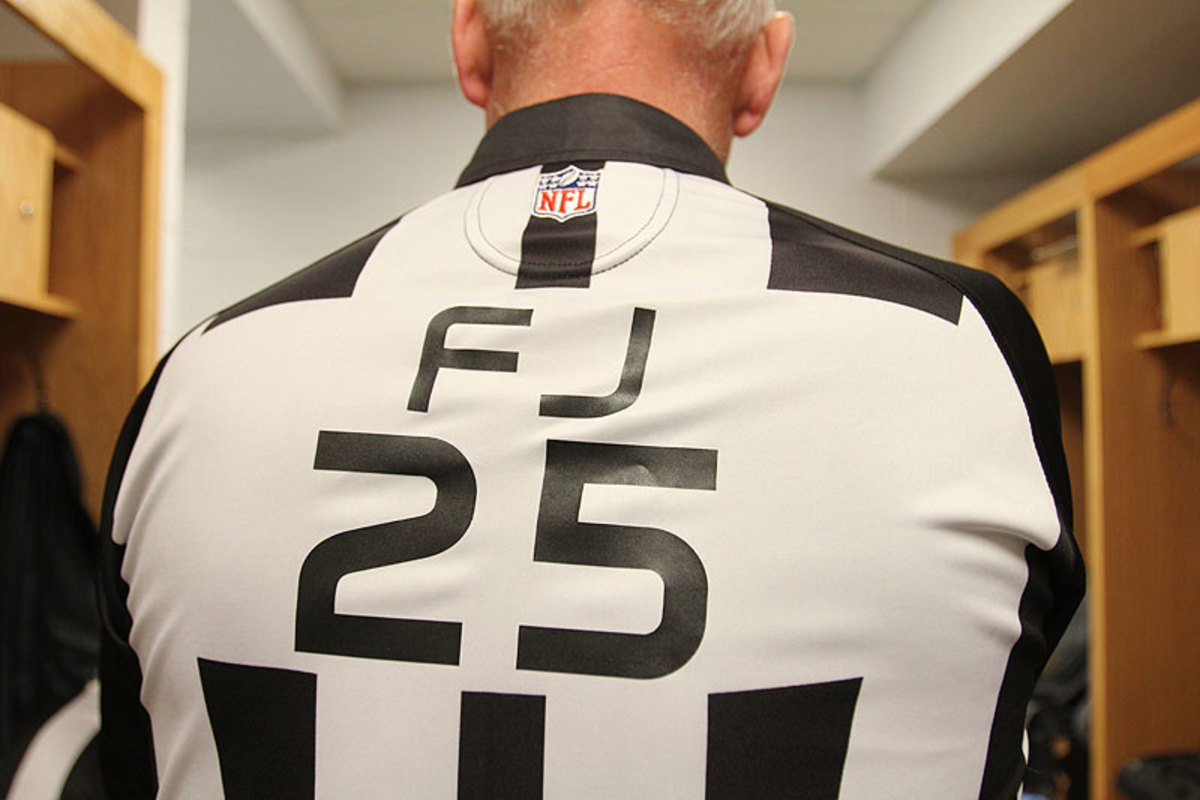
On the field before the game, Steratore meets Trestman, who’s in his first NFL head coaching stint, for the first time. “Look forward to working with you many years, coach,” Steratore says. When the players leave the field, Steratore does a mike check. “Testing, referee’s mike check,” Steratore says. “Testing 1-2-3. Lisa, Lisa, 1-2-3.”
On his way back into the locker room, Steratore looks worried. Game 150 is 26 minutes away, and the sky is like something from The Wizard of Oz just before the house is swept away. “They say there could be 70- mile-an-hour winds in a while,’’ Steratore says. “This could be a wild one.”
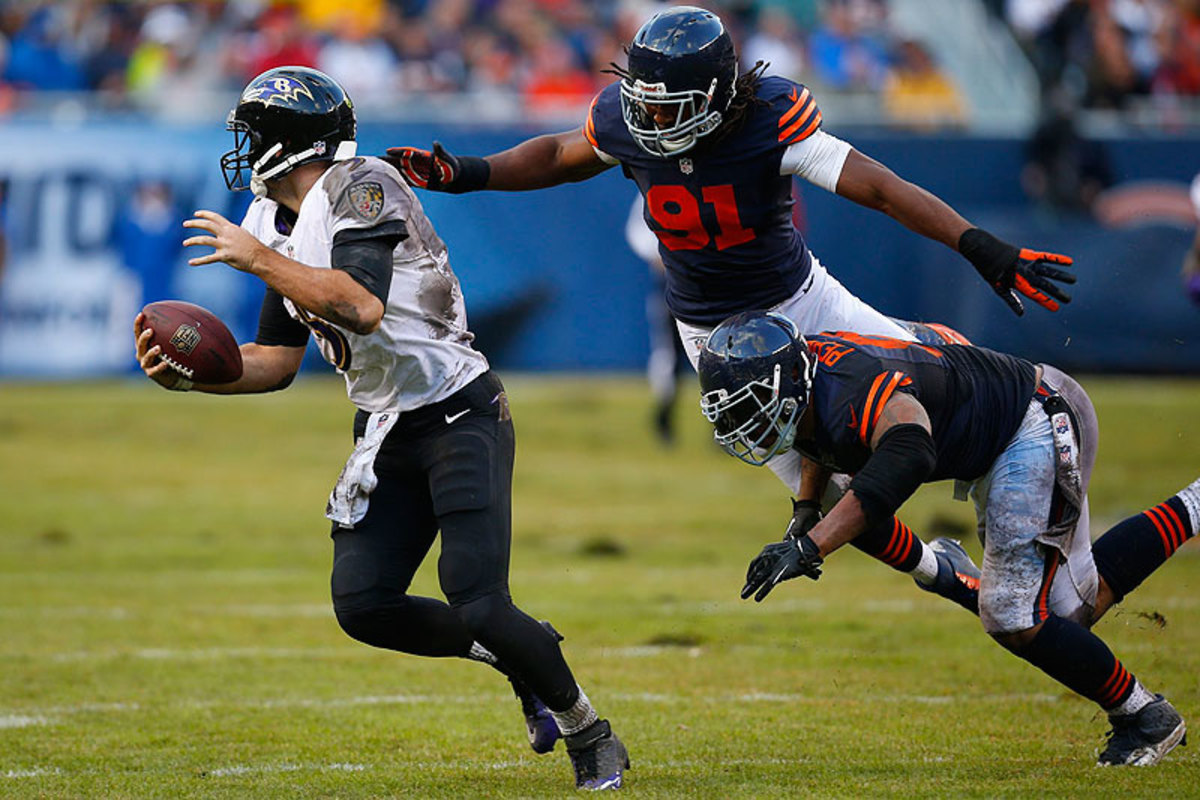
For this crew, four plays in the first six minutes show there will be no Arizona hangover.
Play 6. On a Baltimore punt return, Tandon Doss fumbles while going to the ground. The Bears’ Sherrick McManis picks it up and runs it in for a touchdown. But back at the spot of the fumble, field judge Bob Waggoner is signaling Doss was down. He tells Steratore that Doss’s right knee was on the ground as the ball came loose. The Bears, seeing the replay upstairs, decide not to challenge. Good no-challenge. Would have been fruitless. “The ruling on the field is the runner was down by contact,” Steratore announces. “First down Baltimore.” BOOOOOOOO.
Play 8. Baltimore ball. Stretch play. Run or play-action? Steratore is positioned 12 yards behind the right wide receiver. Schuster is positioned 13 yards behind the left tackle. Here is the precise play they drilled for yesterday. Could be a run or pass. Flacco hands it to Rice, who cuts back toward the left guard. From his vantage point, Steratore now stares at the right guard and tackle, and sees a momentary hook by right guard Yanda on the defensive tackle—but Yanda releases him almost as soon as he is into him; no foul. Schuster, looking at his three offensive linemen in the middle, sees center Geno Gradkowski maul defensive tackle Stephen Paea to the ground. Clean block. No hold. Rice gains 47, cleanly.
Play 10. Flacco throws for the end zone to tight end Ed Dickson on a ball that might be uncatchable. Safety Chris Conte bearhugs Dickson a full second before the ball arrives. Paganelli, watching from the end line, has the yellow flag in his right hand and throws it. Immediately he motions for pass interference and points to Conte. For this he had to rule not only that Dickson—who actually caught the pass on the end line—was interfered with, but that the ball could have been caught in bounds if he hadn’t been interfered with. On replay, it’s clear Paganelli made the right call.
Play 15. A challenge—and one that’s tougher than it looks. Josh McCown throws a short pass to Alshon Jeffery. As Jeffery turns upfield and is tackled, the ball slips out, and the Ravens jump on it. It’s very close as to whether the ball comes out when he is down, or just before—and whether Jeffery completes the act of the catch. Line judge Jeff Seeman immediately runs in and rules catch and down by contact. John Harbaugh throws the red challenge flag.
Steratore, walking to the sideline, wants to make one thing clear to Harbaugh on this rare play. “John, you can’t end up with the ball here,” he tells the Ravens’ coach. “You can have an incomplete pass, but on a ruling of down by contact, the fumble is not a reviewable play.” But Harbaugh tells him he simply wants to challenge the ruling of a completed pass.
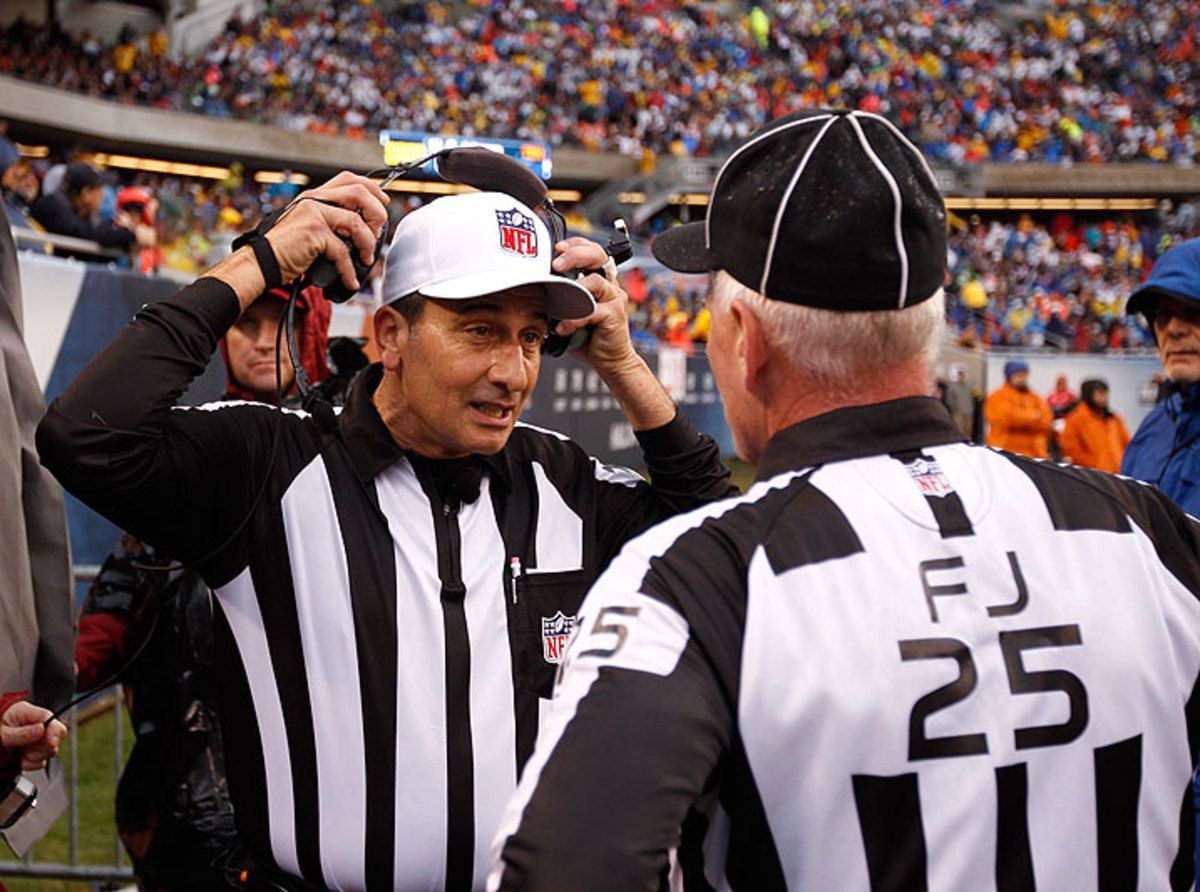
This is as good a time as any in a long story about officiating to talk about the review process.
First, Steratore makes the announcement that the Ravens are challenging the ruling on the field of a completed pass. Then he “punches out for commercial,” meaning with two balled-up fists he punches the air to the side, signaling the TV crew (CBS in this case) to go to a break. Meanwhile, the replay assistant and replay official are gathering the television angles seen by however many cameras are working that game. When Steratore, accompanied by Waggoner, reaches the replay booth behind the Bears’ sideline, he puts his headset on and says to replay official Paul Weidner, “Pauly, you have any good angles for me to see?” Weidner does, and—here’s another ref phrase—he “dumps the bucket” of all the plays he has for Steratore. Once Steratore goes inside the curtains in the portable booth and the screen turns on, a timer begins to run: 60, 59, 58, 57 … . At zero the screen will automatically go black.
From the touch screen, Steratore can choose whichever angle in the bucket he thinks will help. On this play, the first shot is the main live broadcast feed, which Steratore finds inconclusive. The second, a low end zone shot from behind the Chicago offense, suggests that Jeffery lost the ball before it was a catch. Steratore needs more. On the third shot, low from the Chicago sideline, he sees this: Jeffery turned upfield and began to make the football act, in this case to run with the ball, but almost immediately the ball started to come loose. Steratore now is certain the receiver didn’t have the ball long enough for a completed catch.
That determination took about 40 seconds. Now he has to return to the first replay, to confirm which hashmark and yard line the ball was originally on and to get the exact time on the clock when the incompletion happened.
Steratore emerges from the booth, tells Waggoner the ball should be at the Chicago 23, at the near hashmark, and that the clock should be reset to 9:17. Two officials inform each coach, while Steratore goes to the field, waits for the signal from the sideline TV crewman, presses the microphone button on his belt, and announces: “After review, the ruling is an incomplete pass. The receiver did not maintain possession through the process of the catch. The ball is incomplete. It will be Chicago’s ball, third down and seven from the 23-yard line. The ball will placed in the middle of the field. Baltimore will not be charged with a timeout. Will the game clock operator please reset the game clock to 9 minutes, 17 seconds, 9:17 on the game clock please.”
A bit wordy—Steratore didn’t need to give the incomplete notice, nor the time on the clock, twice. But he got the call right. He corrected a bang-bang decision that was clearly in error. That’s what replay is for.

A long Baltimore series later, the skies turn black, the wind whips up, the radar indicates violent weather 25 miles to the west, and, after the league offices in New York consult with meteorologists and Bears officials, play is halted. The crowd is told to clear the stands and head to the protected concourses. The officials retreat to their locker room. There they discuss the situation with Slaughter, their supervisor, and watch the local TV news reports on the severe weather, including tornadoes throughout Illinois. They talk to Blandino in New York, and to the coaches of both teams. “Nothing to do but wait,” Steratore says.
After an hour and 53 minutes, once the weather clears, the teams and officials return to the field, the fans return to their seats, and the game resumes.
There are three borderline plays the rest of the way.
One: With 5:51 left in the first half, Flacco scrambles for a first down, slides, and is hit by Julius Peppers. Steratore throws the flag. Unnecessary roughness on a sliding quarterback who’d given himself up. Peppers immediately throws his hands in the air as if to say, “You gotta be kidding me!” Borderline, maybe—but Steratore was whacked by the league for two non-calls on hits on the quarterback in last week’s game, and it’s folly to think he won’t be extra-sensitive in this game.
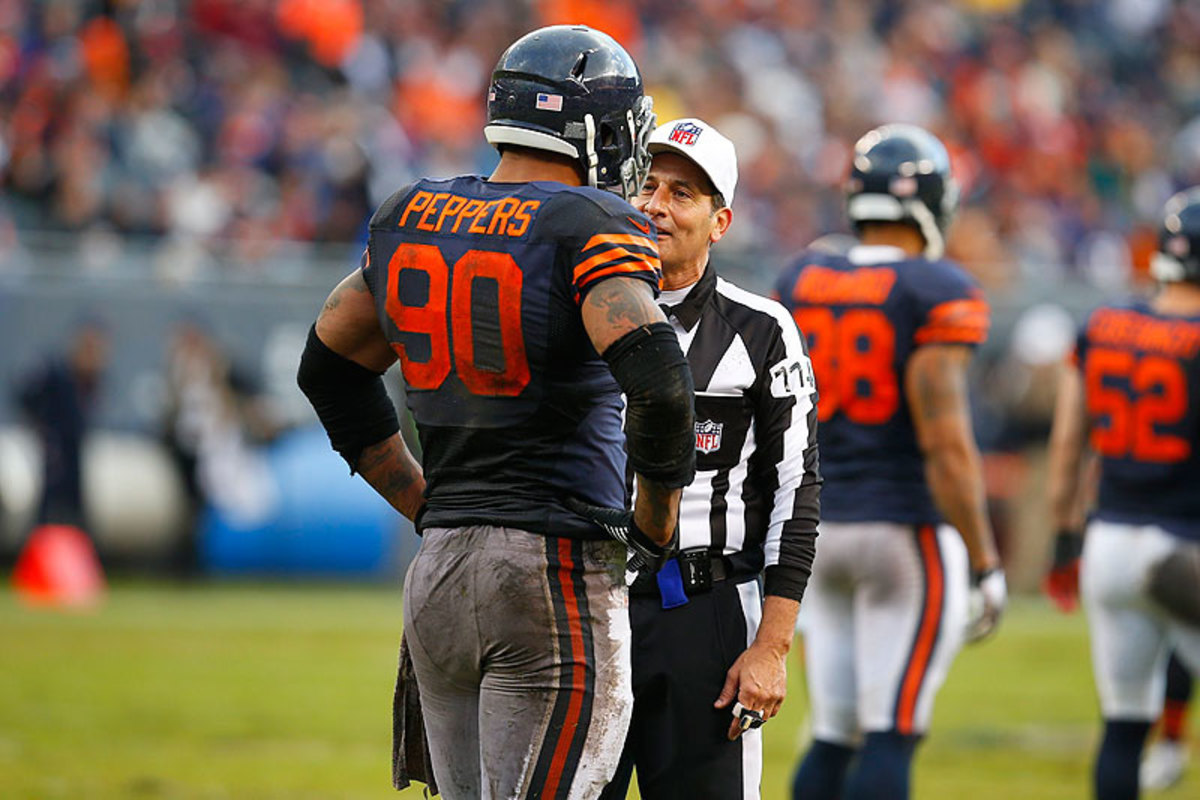
Steratore rarely explains penalties right away to steaming players, because he knows they’re not ready to hear it. So he waits until the Bears take a timeout with 1:07 left in the half and approaches Peppers, whom he likes and respects.
“Look, Julius, if that play happened in my backyard, I’m not calling it,” Steratore tells the three-time All-Pro. “But I get graded too. Just like you.”
“I understand,” Peppers says.
Two: Steratore calls a marginal horse-collar tackle in the second half, from about 25 yards away. The grab of the shirt was high but more from the side than back. It’s a call that will be examined closely by New York three days later.
And three: Baltimore’s Elvis Dumervil shoves McCown down with two hands a second after McCown releases a pass. Not a violent, hard shove, but Dumervil does hit him, and the quarterback falls, and the Ravens go nuts when Steratore throws the flag. When the grousing continues, Terrell Suggs speaks up. “That’s it! It’s over.” Taking over for Ray Lewis, Steratore thinks.
After torrential rain and strong winds and then none of either, and then bone-chilling cold, of course the game goes to overtime. It finally finishes five hours and 16 minutes after kickoff, and the men of the third team on the field trudge up the tunnel, their shoes three times their original weight, from the mud.
When they reach the locker room, Steratore gets on the phone with Blandino, calling from New York. “Dean,” Steratore says, “the divots were coming up huge. That was a tough, tough game. Shoe pulled his hammy.” Indeed, Schuster walked into the locker room limping slightly from a slip and slide in the second half.
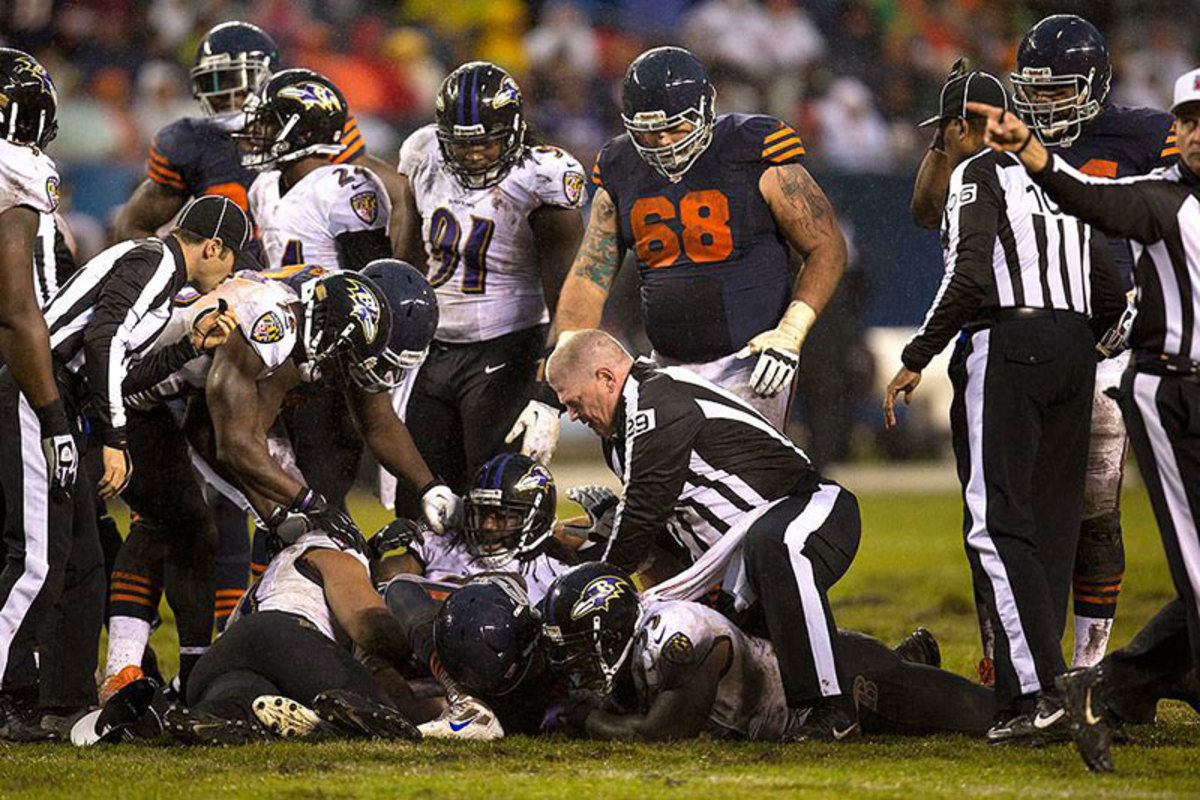
“Guys,” Steratore says, “I just want to tell you: You did a great job today. You did right by the game. You busted your ass, you stayed focused, and you did a great job.”
“I came in to break up a little scrum at one point,” says the reed-thin Paganelli, “and the wind almost blew me over.”
“I loved it out there,” says Schuster. “Mud and glory. Classic football. Like what John Madden said: ‘Nice to get back to real football for a change.’ From hash to hash, nothing but loose divots. They were coming up like briefcases.”
“We weren’t the story,” says Steratore. “That’s the best thing.”
Now they’re hustling for quick showers and the airport; the violent weather made a mockery of the field, and of the officials’ travel itineraries. As much as they’d like to take a few deep breaths and relive an unforgettable Game 150, they mostly want to get to the airport. The Paganelli kids have school in the morning, for one thing. Dad has to get home.
But first …
“Hey,” says Schuster, “what was the final?”
“It was 23-20,” Steratore says. “Chicago.”
Epilogue
Tuesday, Nov. 19, Washington, Pa.
The email from Gary Slaughter arrives in Steratore’s inbox at 2 p.m. Steratore calls up the Ref360 program and finds Game 150.
Moment of truth.
No downgrades.
Zero. Slaughter, the grader, praises the crew for keeping its focus in terrible conditions. Steratore is euphoric.
There are two “support-only” calls, meaning the grader might disagree but acknowledges that there was sufficient reason for the call. Both are from Steratore. The flag on Peppers is one that Slaughter wouldn’t have thrown, and the horse-collar tackle is close but Slaughter doesn’t like that one either. In the league’s officiating command center the next day, however, Blandino says he understands why Steratore threw both flags, erring on the side of safety, and wouldn’t mark him down for either. “The crew had a great game in Chicago,” Blandino says. “A lot of tight stuff throughout the game, and a lot of good calls. I thought it was a great bounce-back week.”
Even amid the joy of the Grade-A game, the Peppers call troubles Steratore. If I don’t get downgraded last week for those plays in Arizona, would I throw the flag on Peppers? After beating himself up over it for a while, he thinks to himself that he’d still be decisive, grades be damned.
That’s what Blandino wants—officials who don’t think of grades, but rather of the right calls. Even when the right calls are as gray as the Chicago sky was for most of the game Sunday. Not shades of gray. Dark, pure, perfect gray.
“Damn it,” Steratore says this night, “I know what a penalty is.”
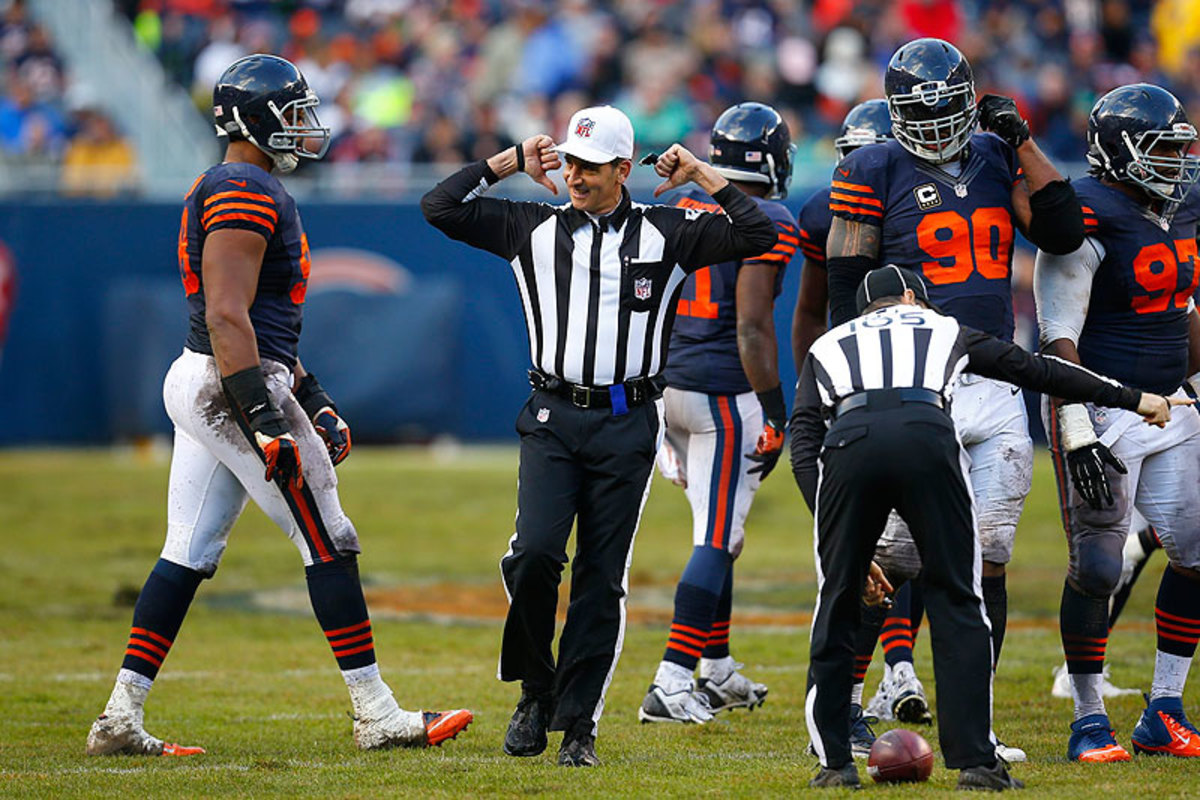
On that week’s conference call, Steratore tells his crew: “That’s the most unusual game we’ll ever work. It’s our first zero of the year. That’s an incredible job. To hang in there for five and a half hours, tornadoes in the area, all the wind, the ran, the mud, horrible conditions …
“We are right back where we want to be. This thing ain’t broke.”
Question or comment? Email us at talkback@themmqb.com.
